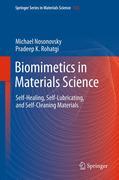
Biomimetics in materials science: self-healing, self-lubricating, and self-cleaning materials
Nosonovsky, Michael
Rohatgi, Pradeep K.
Biomimetics in Materials Science provides a comprehensive theoretical and practical review of biomimetic materials with self-healing, self-lubricating and self-cleaning properties. These three topics are closely related and constitute rapidly developing areas of study. The field of self-healing materials requires a new conceptual understanding of this biomimetic technology, which is in contrast to traditional engineering processes such as wear and fatigue. Biomimetics in Materials Science is the first monograph to be devoted to these materials. A new theoretical framework for these processes is presented based on the concept of multi-scale structure of entropy and non-equilibrium thermodynamics, together with a detailed review of the available technology. The latter includes experimental, modeling, and simulation results obtained on self-healing/lubricating/cleaning materials since their emergence in the past decade. Describes smart, biomimetic materials in the context of nanotechnology, biotechnology, and self-organization. Covers self-healing, self-lubricating, and self-cleaning materials with applications to green technologies in areas such as energy, biomedical devices, and defense. Presents a unified approach by leading researchers in the field covering both theoretical and practical issues. INDICE: Preface. Chapter 1. Introduction. PART ONE. SELF-HEALING MATERIALS. Chapter 2. Thermodynamic principles of self-healing in metallic materials. Chapter 3. Case study of self-healing in metallic composite with embedded low melting temperature solders. Chapter 4. Surface healing: a case study. Chapter 5. Development of Metallic and metal matrix composite self-healing materials. PART TWO. SELF-LUBRICATING MATERIALS. Chapter 6. Friction, wear, and self-lubrication. Chapter 7. Thermodynamic methods in tribology and friction-induced self-organization. Chapter 8. Tribological properties of metal matrix composites. PART THREE. SELF-CLEANING MATERIALS. Chapter 9. Thermodynamic foundations ofwetting and capillary phenomena. Chapter 10. Superhydrophobicity. Chapter 11.Lotus-effect and self-cleaning. Chapter 12. Self-cleaning in the water flow. Chapter 13. Artificial self-cleaning surfaces. Chapter 14. Outlook.
- ISBN: 978-1-4614-0925-0
- Editorial: Springer New York
- Encuadernacion: Cartoné
- Páginas: 435
- Fecha Publicación: 28/10/2011
- Nº Volúmenes: 1
- Idioma: Inglés
